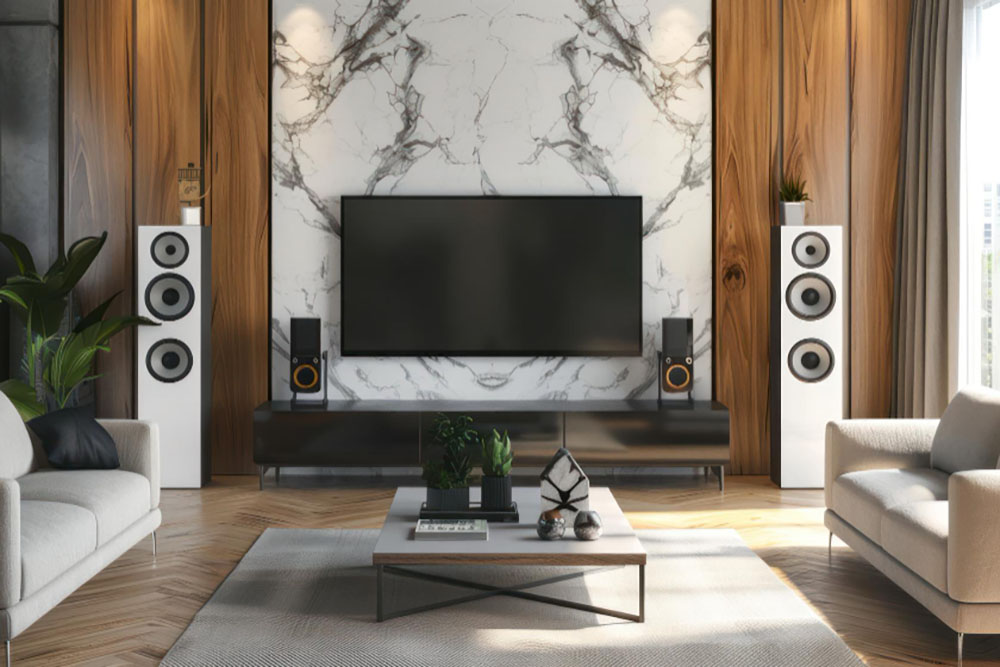Things to Consider for Top-notch Audio in Your Home Theater

A home theater is more than just a luxury; it's an experience. If you're planning a home theater installation in Central Florida, you're in the right place. Understanding the nuances and intricacies of setting up a high-fidelity audio system can be a game-changer. This guide will walk you through the essential factors to consider for achieving top-notch audio in your home theater.
1. Room Acoustics and Layout
Importance of Room Acoustics
The first step in creating an exceptional audio experience is understanding your room's acoustics. The dimensions, materials, and shape of your room significantly impact sound quality.
Tips for Optimizing Room Acoustics
- Shape and Size: Rectangular rooms generally provide better acoustics compared to square rooms. Avoid rooms with too many parallel walls, as these can create standing waves.
- Materials: Hard surfaces such as glass and concrete can reflect sound, causing echoes. Use carpets, drapes, and acoustic panels to absorb and diffuse sound waves.
- Furniture Placement: Your seating arrangements and furniture placement can affect the sound distribution. Arrange them thoughtfully to ensure a balanced audio experience.
2. Speaker Selection and Placement
Choosing the Right Speakers
Selecting the right speakers is crucial. There are various types of speakers, including floor-standing, bookshelf, in-wall, and satellite speakers. Each type has its strengths and drawbacks.
Tips for Speaker Placement
- Front Speakers: Place your front speakers at ear level and equidistant from the primary seating area.
- Center Channel: Position the center channel speaker directly above or below your TV screen, aligned with the front speakers.
- Surround Sound Speakers: Place these slightly behind and to the sides of the primary seating area. Ideally, they should be at ear level or slightly above.
- Subwoofer: Subwoofers are less location-sensitive but placing them near a wall or in a corner can enhance bass response.
3. Acoustic Treatments
Why Acoustic Treatments Matter
Acoustic treatments can dramatically improve your home theater's sound quality by managing reflections, absorption, and diffusion.
Types of Acoustic Treatments
- Absorption Panels: These panels help reduce reflections and echoes. Install them on walls and ceilings.
- Diffusers: Diffusers scatter sound waves, preventing echoes without deadening the room.
- Bass Traps: These are designed to absorb low-frequency sound waves. Place them in corners where bass tends to accumulate.
4. Audio Calibration
Importance of Calibration
Even the best equipment won't perform optimally without proper calibration. Calibrating your audio system ensures balanced sound across all frequencies and channels.
Tools for Calibration
- Sound Meter: A sound meter helps measure sound levels in your room, ensuring each speaker is properly balanced.
- Calibration Software: Many modern AV receivers come with built-in calibration software that uses a microphone to automatically adjust settings.
- Professional Help: For the best results, consider hiring a professional for audio calibration. Their expertise can make a significant difference.
5. Quality Cables and Connections
Why Cables Matter
Quality cables can have a big impact on your audio experience. Inferior cables can introduce noise and degrade sound quality.
Tips for Choosing Cables
- Speaker Cables: Choose high-quality, oxygen-free copper cables for the best sound quality.
- Interconnects: Use shielded interconnect cables to reduce interference.
- HDMI Cables: For connecting your components, use high-speed HDMI cables that support the latest standards and features.
6. Choosing the Right AV Receiver
Role of the AV Receiver
The AV receiver is the heart of your home theater audio system. It processes audio signals and distributes them to your speakers.
Features to Consider
- Power Output: Ensure the receiver has enough power to drive your speakers efficiently.
- Number of Channels: Choose a receiver that supports the number of speakers in your setup.
- Connectivity: Look for receivers with multiple HDMI inputs, Bluetooth, and Wi-Fi capabilities.
- Room Calibration: Many modern receivers come with automatic room calibration features, which can greatly simplify the setup process.
7. Streaming and Source Components
Importance of Quality Sources
The quality of your audio source significantly impacts your overall listening experience. High-resolution audio files and streaming services provide better sound quality compared to standard MP3s.
Recommended Sources
- Blu-ray Players: For the highest audio and video quality, Blu-ray players are a great option.
- Streaming Services: Services like TIDAL, Qobuz, and Amazon Music HD offer high-resolution audio streaming.
- Media Servers: If you have a large library of digital media, consider investing in a media server for easy access and playback.
8. Smart Home Integration
Benefits of Smart Integration
Integrating your home theater with smart home technology can enhance convenience and control. Use voice commands, mobile apps, and automation to manage your home theater system seamlessly.
Recommended Smart Devices
- Smart Speakers: Devices like Amazon Echo and Google Home can control your AV receiver and other components using voice commands.
- Smart Lighting: Adjust your room's lighting to match the mood of your movie or show.
- Universal Remotes: Simplify control with universal remotes that can manage all your home theater components.
9. Regular Maintenance
Importance of Maintenance
Regular maintenance ensures your home theater system continues to perform at its best. Dust, heat, and wear can affect the longevity and performance of your equipment.
Maintenance Tips
- Clean Regularly: Dust your components and clean your speakers to prevent buildup.
- Check Connections: Periodically check all cable connections to ensure they are secure and free from corrosion.
- Software Updates: Keep your AV receiver and other components updated with the latest firmware for optimal performance.
Conclusion
Achieving top-notch audio in your home theater requires careful planning, quality components, and expert installation. By considering factors such as room acoustics, speaker placement, and proper calibration, you can create an immersive audio experience that enhances your entertainment.
If you're planning a home theater installation in Central Florida, contact Axiom Integration today to get your free quote. Our team of experts will help you design and install a system that meets your unique needs, ensuring you enjoy the best audio experience possible.